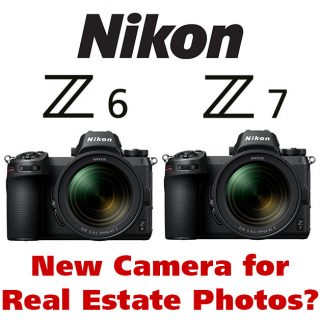 Nikon unveiled its new full-frame mirrorless cameras last Thursday: the Nikon Z6 and Z7. These models are supposed to strike fear into the heart of Sony, currently being market leader in this camera segment with their successful Alpha 7 series. Now, since all the show-smoke had vanished, it is time for a little analysis on whether the cameras can be the new stars for real estate photographers.
Nikon unveiled its new full-frame mirrorless cameras last Thursday: the Nikon Z6 and Z7. These models are supposed to strike fear into the heart of Sony, currently being market leader in this camera segment with their successful Alpha 7 series. Now, since all the show-smoke had vanished, it is time for a little analysis on whether the cameras can be the new stars for real estate photographers.
So much in advance: Nikon has presented two very powerful cameras promising first class image results, and obviousely they do deliver great photos according to the first (independent) images shown.
But, what about real estate photography? Can real estate professionals benefit from the new cameras?
Further down in this post I will also refer to some of the negative critique from the first reviews to find out how far these are relevant to real estate photography.
Meanwhile this article contains four updates, which became known after it had been published.
Analysis of First Reviews
For me, the last three days have been exhausting, since I’ve read, heard and seen 56 international reviews online (up to now). These came from photographers, photobloggers and technical journalists, whom I follow on the internet on different channels. They were invited by Nikon to different locations in the world to have the new cameras presented, to take them in their own hands and take pictures or video with them.
Their published reports varied a lot: huge euphoria, moderate tones, slight disappointment and slating reviews – obviously, Nikon can not get it right for everyone with their new entry into this camera segment. The demands and expectations of the Z6 and Z7 are quite high, after all we are talking about a camera class that is already popular with photo professionals. In addition, these reviewers had so-called pre-production models in their hands, so that maybe not everything went completely as desired. Until the launch of the Z7 at the end of September there is still time for corrections (at least in the software area). The Z6 should then be available for Christmas business.
Two Cameras for Different Applications
I don’t really want to discuss all the technical data at this point. Anyone interested can get information from Nikon online. Only so much in advance:
Both cameras have an identical body, but differ in the following key features:
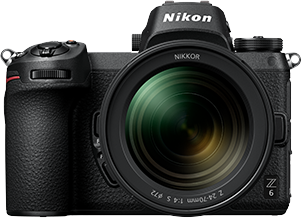
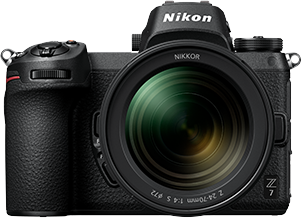
There are a few more differences in the areas of video and energy. Most other functions are identical. The difference between the two cameras is comparable to that of current DSLR models between Nikon D750 and D850. However, the new cameras are significantly smaller than their counterparts with mirror box. In addition, the Z6 is 20 percent lighter than the D750 and the Z7 weighs 26 percent less than the D850.
However, when you connect your old Nikon lenses to the camera with the available adapter, the advantage in size in the longitudinal axis is almost gone.
Cameras of a Higher Class
In my opinion both cameras are targeted to so-called prosumers, shooters so with a professional claim but being still consumers. This puts them in the same category as the D750 and D850. Nevertheless, many professional photographers will probably equip themselves with the new cameras – because they expect a tremendous quality at a reasonable price. A pure professional camera, such as the Nikon D5 (DSLR) or the Sony Alpha 9 (mirrorless) acts a separate segment, even financially.
Nikon Z6 or Z7 for Real Estate Photos?
According to the information on paper, I would tend to the cheaper Nikon Z6 for real estate photography. I see three reasons for this:
- The Z6 must accommodate less megapixels on the same sensor area, each of which can therefore be larger. Larger lightsensitive elements, work more precisely. This, in turn, causes lower image noise. In particular, real estate photos are often heavily edited in post-production to re-gain details in the brightest and darkest parts of the image. This considerably increases the existing background noise (even with ISO 100). However, image quality would benefit, if noise is already low when capturing the frame.
- In addition, the files of the Z6 are smaller and require less computer performance when processing the images.
- The argument that one can crop parts out of the 45 megapixels of the Z7, does not apply to real estate photos. A crop of an image is, apart from the loss of resolution, nothing else than the use of a telephoto lens. However, we need more wide-angle in the great majority of scenes – in other words, exactly the opposite.
New Lens Mount and New Lenses
The main innovation is that Nikon has developed a new lens connector, the so-called Z-mount. It is much larger than the 60-year-old F bayonet of previous SLR cameras. This allows significantly more light to pass in the direction of the sensor. In addition, the sensor has moved much closer to the lens (flange distance only 16 mm). Both contribute to the fact that smaller and lighter lenses with significantly improved image quality towards the edges of the image and in the corners can be used. That’s exactly what real estate photographers want.
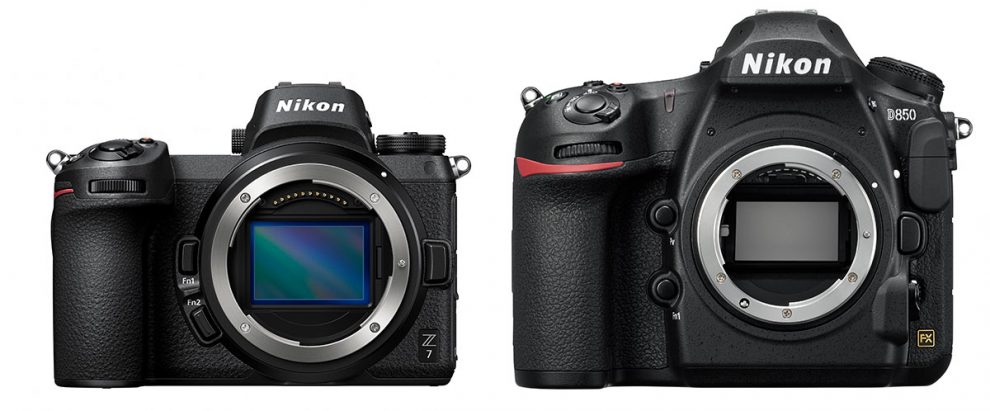
Nikon Z7 and D850 in comparison: The Z7 has a larger lens mount, while the D850 has a smaller bayonet and the sensor is placed further back in the camera. The body of the Z7 is much smaller.
Nikon’s required S-lenses are absolute new developments and are published step by step – there is a road map until 2021. The data for twelve lenses are fixed, for eleven other models in the years 2020/21, the key data are not yet known. At launch Nikon introduces three lens models, which are less interesting to real estate photography, because of their focal lengths. However, if you want to continue using your old Nikon glas for the time being, you can connect it to the camera with an adapter without any loss of function. Even the lenses of secondary manufacturers seem to work. But this should be checked separately for each model. Reports about this will certainly appear online in the near future.
Favourite Features Included
Improved Wifi Connectivity could be a great deal for real estate photography. But this definitely requires a practical test, if possible with a simple and efficient workflow.
Other features that have a positive impact on real estate photos, but also can be found on many other camera models (also from Nikon):
- Handling: Almost all Nikon SLR cameras feel very good in the hand. Also, the handle of the Z6 and Z7 has this DNA and is superior to competitor Sony.
- Menu: The industry has actually agreed: Nikon has one of the best menu systems. So obviously there was no reason to change the structure. Of course, new menu items have been added.
- Controls: Nikon uses the proven knobs and buttons. They provide a good grip and defined pressure points.
- Touchscreen: The menu operation, especially the quick menus via the i-button, and the selective focus via the camera screen contribute to a more efficient photography process.
Image Dynamics not specified
There is information that I could not find so far, but is quite important for real estate photos: image dynamics. This number tells you over how many brightness levels the camera can display details. This is of great importance with the enormous differences in light that occur in indoor shots. In the technical specs, I did not find such info, German advertising materials only speak of an „amazing dynamic range“.
Update of 03-08-2019 and 03-14-2019: The camera test laboratory DxOMark has also determined values for the image dynamics with its test results. The Z6 lies with 14.3 EV just below its mirror DSLR counterpart D750 and the Z7 with 14.6 EV just below the similarly high-resolution D850. In both cases, however, considerable values. In this sensor class, there are currently only a few cameras that can keep up, mainly from their own brand, as well as from Sony and Pentax. On the other hand, the Z6 clearly has the edge in terms of image noise and is only topped by the top models from Sony.
Negative Critique for Nikon Z6 und Z7 (and its Importance for Real Estate Photography)
Both the moderate and the dedicated critics have reported the same few deficiencies. Often these are not real mistakes, but unfulfilled expectations. Do these points of criticism play a role for real estate photography?
1. Just One Memory Card Slot
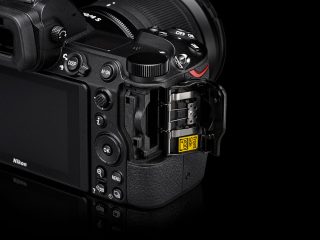
Memory Card Slot of Nikon Z6 und Z7
This is probably the biggest uproar that drives the critics on the net. For many cameras in the more professional segments, it is now common that there is room for two memory cards. The task of the second memory card can usually be defined via the menu, such as:
- It serves as a memory extension, when the first card is full, the camera continues to store on the second one.
- If you take pictures in two different file formats, the camera can save one file version per card.
- One memory card contains photos, the second one is reserved for video captures.
- The second card serves as a backup drive because both cards store the same photo at a time.
Exactly at the last point the critique starts, because the Z6 and the Z7 have only one card slot each on board. The critics justify this with possible data losses due to a possibly defective memory card and therefore rely on this type of instant data backup. At the new cameras they miss this function painfully.
In my opinion, this is only relevant in hectic working environments, because the density of events prevents permanent image control. Or this applies for capturing irretrievable moments. I think of photojournalists in sports or in crisis regions or even wedding and event photographers.
For real estate photography, this argument is irrelevant.
2. Expansive XQD Card instead of SD Card
This is where many photographers begin to howl and their wallets start to cry. Nikon installs one slot for the much more powerful XQD card in their two new cameras . It is not compatible with the familiar SD format. And it is many times more expensive.
Nikon has obviously opted for this because XQDs can read and write data much faster. This is especially interesting for journalists or for videographers.
For real estate photography, this argument is just a (uniquely painful) cost factor.
3. No Eye Autofocus
The title says it already. It’s about photography of subjects with eyes. For example, we love portraits when the eyes (at least the one closer to the camera) are absolutely sharp. Both cameras do not have this popular focus automatic. The critics must therefore use another classic focus technique while shooting. But there is at least face recognition in video mode in order to automatically focus on the respective talent.
For real estate photography, this argument is irrelevant.
Update 03-02-19: At CP+ photo show in Yokohama Nikon had presented a firmware update with eye detection capability for these cameras. First tests showed that this technology can compete with the powerfull eye AF of current Sony models. You will be able to download this update from the Nikon website and install it on your cam.
4. Not Enough Lenses and Lack of Fast Apertures
For the start of the Z7, there will initially be two lenses: a lightweight wide-angle lens 35 mm f1.8 and an all-round zoom lens 24-70 mm f4. Two months later with the Z6, there will also be a standard lens 50 mm f1.8. Critics moan that these are too few lenses. However, they should remember that they are all new developments and that there were no developed cameras for the hard test of many models.
Lens variety
In addition, the lens selection is criticized: The 35 is a reporter lens and is suitable for the genre of streetphoto, so it has a limited scope. The 24-70 as an all-rounder is not stretched far enough. Required is a 24-120. And the 50 is too expensive with 679 EUR, especially since the old DSLR version currently costs around 200 EUR only.
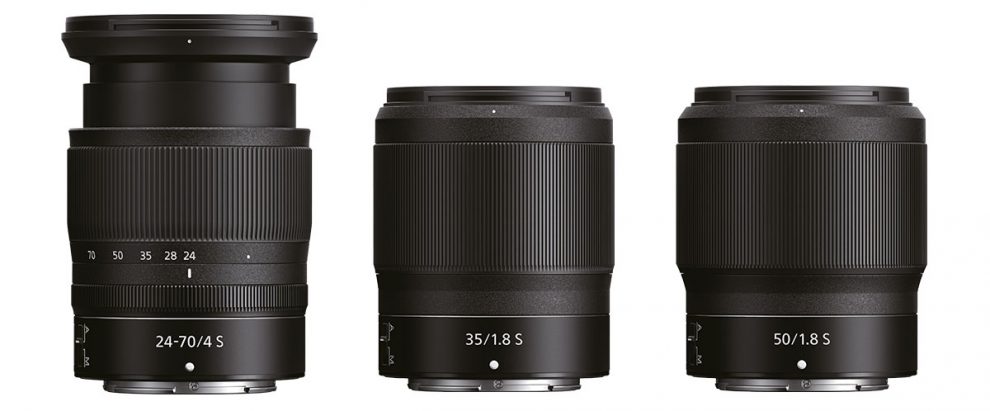
Slim lens construction of Nikon S for the start.
Left: zoom lens 24-70 mm f4 | Middle: moderate wide-angle lens 35 mm f1.8 | right: normal lens 50 mm f1.8
In addition, some testers demand that Nikon should better launch faster models of the fixed-focal-length lenses with values of f1.4 or even f1.2 in order to exploit the optical advantages of the new system.
All mentioned focal lengths do not play a major role in real estate photography, because the strong wide-angle range according to the Nikon roadmap will only be considered in 2019 with a 14-30 mm f4 and in 2020 with the 14-24 mm f2.8.
Update of 01-08-2019: The ultra wide angle zoom 14-30 mm f/4 is announced and should be in the shelves at around April – though for a retail price of EUR 1,449.
In the meantime you can use the FTZ adapter offered by Nikon and use almost 100 existing lens models of the DSLR system.
For real estate photography, this argument is irrelevant.
5. Tilting Monitor instead of Flip Screen
Many professionals say in their tests that the camera developers did not implement enough professional features. The next moment they complain that they can not use their professional tool as a vlog camera to film themselves. In my opinion, here opens a big gap of different approaches. And all, because you can not see yourself in the monitor when you are in front of the camera. Because the screen can only be folded up and down, but not 180°. And it can not swing to the side and at the same time turn to face the front side.
Since the D750 I have found it very pleasant to be able to choose the camera angle with the tilting display back-friendly from the top. Every now and then it is annoying when you shoot in portrait format and then just can not judge the image from above, because the of camera rotation the screen is only foldable sideways. However, over 90 percent of my pictures are in landscape format.
For real estate photography, this argument is irrelevant.
6. No 4k 60p
This relates to the video function of the camera. It means a higher frame rate at higher resolution to generate more fluent videos.
For real estate photography, this argument is irrelevant.
7. No GPS
If you get around a lot, it’s nice to know later where exactly which picture was taken. Some cameras have a GPS module that communicates with satellites and reports the current location to the camera. This information is then stored invisibly in the image file during capturing. Later it can be displayed on the computer.
It may be interesting to understand where a marketed property was located. But it is questionable how important this function is. After all, most of the photos are taken indoors. However, the GPS connection is extremely unstable without a clear view of the sky. In addition, most of the images are processed same day and are either immediately put into a folder on the computer or even get a file name, which shows the location. In addition, a GPS module consumes power, which may reduce the number of image captures with the current battery charge.
For real estate photography, this argument is irrelevant.
8. No Backlit Buttons
For professional camera models, the buttons on the back of the camera are backlit, so you can operate the camera in the dark. That’s a nice product feature.
However, according to my experience in almost all properties there is still so much light available that you can identify the buttons without light assistance. And in very rare cases, when it is really not possible (for example, when shooting outdoors at dusk), the lamp of your smartphone can help out.
For real estate photography, this argument is irrelevant.
9. Not very reliable Continous Autofocus in Bad Light
We are photographing real estate. Buildings stand still. Continuous AF, for example, is for sports photographers who need to track moving athletes with the camera and respond to rapid focus changes.
If this phenomenon is now increasingly noticeable, this is a childhood disease of the new camera system. So Nikon will work on the camera software and soon provide an update and of course deliver new cameras with the current version.
For real estate photos, however, static single-autofocus is always preferable.
For real estate photography, this argument is irrelevant.
Conclusion
- In the near future, there will be two powerful mirrorless full-frame cameras with the Nikon Z6 and Z7, which will make photography even more fun.
- However, we are looking at a new system of which only pre-production models have been tested so far.
- For real estate photos, the Nikon Z6 is better.
- In terms of cost, existing Nikon lenses can be used on the cameras with the FTZ adapter.
- The main criticisms of the testers are largely irrelevant for real estate photography.
For whom are Nikon z6 and z7 suitable?
- Professional photographers will use these cameras. They save space and weight, especially when it comes to mobile jobs.
- Photographers who have photographed with Nikon so far and are now faced with a camera change will opt for the new models because, in addition to high photographic quality, they benefit from the reusability of their existing lenses.
- Photographers will move from other brands to these Nikon cameras because Nikon combines the industry-recognized benefits of great haptics (grip and buttons) and operation (menu navigation) with the advantages of mirrorless full-frame cameras.
- There will also be some newcomers who will equip themselves with the Z6 or Z7 and gradually develop their photographic skills. This process will take some time and requires some endurance.
- For real estate professionals who are serious about getting better photos for their objects, the Nikon Z6 is a world-class tool.
Will I get me one of these cameras?
Belly says „yes“, head (still) says „no“. My Nikon D750 is currently the workhorse and takes great shots with the Tamron 15-30 lens and some other Nikon lenses. If a new purchase will be necessary, I tend to the Nikon Z6 with FTZ adapter.
Of course, as soon as I see the chance to test this camera myself, I will not hesitate.
Update of 03-08-19: Today the test platform DxOMark has released test results for the Z6. As a conclusion, the difference to the D750 is currently too small for me to justify a system change. Here you will find the camera comparison.

